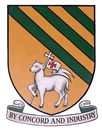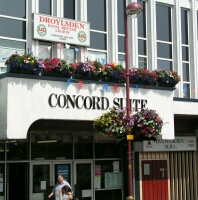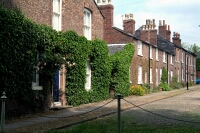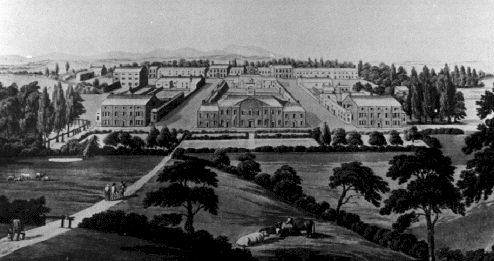Droylsden
Droylsden Town Centre
Services in Droylsden
Tameside Image Archive
Take a look at the historical images of Tameside we have available.
Coat of Arms
 By Letters Patent dated 16 October, 1950 the Garter Principal King of Arms, the Clareceux King of Arms and the Norroy and Ulster King of Armsin in pursuance of the Warrant of His Grace The Most Noble Bernard Marmaduke Duke of Norfolk, Earl Marshal and Hereditary Marshal of England, did grant and assign unto the Droylsden Urban District Council the Arms following, that is to say:
By Letters Patent dated 16 October, 1950 the Garter Principal King of Arms, the Clareceux King of Arms and the Norroy and Ulster King of Armsin in pursuance of the Warrant of His Grace The Most Noble Bernard Marmaduke Duke of Norfolk, Earl Marshal and Hereditary Marshal of England, did grant and assign unto the Droylsden Urban District Council the Arms following, that is to say:
Or three Benlets enhanced Vert in base a Lamb passant proper supporting a Cross-staff flying a Pennon Argent charged with a Cross Pattee Gules.
The Arms granted to the township in 1950 incorporate the Arms of the Byron family, to which the famous poet Lord Byron belonged, who were Lords of the Manor of Droylsden. Clayton Hall, the early home of the Byron's and its moat still exists along side St Cross Church, Clayton, though now part of Manchester. Added to these is the Holy Lamb, the emblem of the Moravian Church.
Motto: By Concord and Industry
History of Droylsden
 Early History
Early History
The origins of the township are obscure. Some believe that it existed in the 7th century AD, but it was probably first mentioned by name in 1250. There are various interpretations of the meaning of the name. It could mean Drygel's valley - 'Drygel' being a companion of war -or dry valley or dry spring - 'dryge' being Old English for dry.
Industrialisation
 The population in 1831 was 3,000, by 1861 it had risen to 8,000 and in 1900 it was 11,000. From 1931 to 1951 it increased from 13,000 to 26,000, but by 1991 it had fallen to 22,676. These periods of population increase show the main periods of expansion in Droylsden's history. During the 1830s and 1840s the construction of large factories and cotton mills began, and labour from the surrounding areas helped to increase the population. Schools were built, the parish church opened, recreation activities organised and local sport was in its heyday. By 1850 the local population was changing over from cottage and farm work to an industrial factory system. Five cotton mills were established by 1850. This number increased to eight by 1875.
The population in 1831 was 3,000, by 1861 it had risen to 8,000 and in 1900 it was 11,000. From 1931 to 1951 it increased from 13,000 to 26,000, but by 1991 it had fallen to 22,676. These periods of population increase show the main periods of expansion in Droylsden's history. During the 1830s and 1840s the construction of large factories and cotton mills began, and labour from the surrounding areas helped to increase the population. Schools were built, the parish church opened, recreation activities organised and local sport was in its heyday. By 1850 the local population was changing over from cottage and farm work to an industrial factory system. Five cotton mills were established by 1850. This number increased to eight by 1875.William Miller Christy developed a hat-making concern in London and Stockport during the 19th century, and his three sons continued the business. William Miller Christy expanded the firm into the textile field and Stockport and Droylsden were the two main centres.
The Droylsden branch opened in 1837 for the manufacture of shirtings at Fairfield Mills. The firm contributed towards the construction of workers' cottages nearby, a school and gas works. A total of 960 employees worked in the mill at this time. The development of the well-known Turkish towel came in 1851 after James Christy, the son of William Miller, saw the unusually looped cloth on a visit to Turkey and brought back a sample.
The first terry towel - the first machine woven towel in the world was produced in Droylsden in a specially adapted loom.
Droylsden had no direct road link with Manchester until the 'New' Road was constructed in 1826 from Manchester to Ashton, passing through Droylsden, where there was a toll gate. The Manchester to Ashton and Oldham area canal, built after 1792, also passed through Droylsden, which was later connected to the High Peak and Cheshire by canal. Coal, lime and manure were the main freight. Railway stations were opened; in 1841 the Fairfield for Droylsden station on the Manchester - Sheffield - Lincolnshire railway; in 1846 Lumb Station on the Ashton - Stalybridge Junction.
The Moravians
 The Moravian Settlement was established in Droylsden at Fairfield in 1783. Originally the society had been established at Dukinfield in 1743 but, when the land lease expired, 54 acres of land was purchased in Fairfield.
The Moravian Settlement was established in Droylsden at Fairfield in 1783. Originally the society had been established at Dukinfield in 1743 but, when the land lease expired, 54 acres of land was purchased in Fairfield.Education was an important part of Moravian life and, although the schools constructed were not very large, they left a permanent and continuous tradition of education for over 150 years. The first Moravian Sunday School in England was opened at Fairfield in January 1793. Their schools were for boys and girls - day schools as well as Sunday Schools - and were open to non-Moravian children. The Girls' Boarding School was opened in 1796, the Boys' Boarding School in 1803. Fairfield High School for Boys opened in 1871 but closed in 1891 due to competition from Manchester.
In Droylsden itself, during the mid 19th century, there was an unusually high number of different types of schools and institutes. There were seven Sunday Schools, a mechanics institute and a night school opened by William Chadwick. Yet more schools were attached to religious groups, others belonged to mills such as the Angola Mill and Droylsden Mills. The Mechanics' Institute and Young Men's Association also had libraries.
Charles Hindley (1796-1857) had strong links with Droylsden, education and the Moravians. He was born in Fairfield and educated in the Moravian Settlement and at the Moravian School in Fulneck, Yorkshire. He became a teacher at a Moravian school in Northern Ireland, but returned to Droylsden after the death of his father and brother to take over the family cotton spinning business. As an active campaigner in the field of education and factory reform it is ironic that his mill in Dukinfield was one of those to be prosecuted after the passing of the Ten Hours Bill in 1847.

Co-operative Society
Droylsden formed its own industrial Co-operative Society in December 1861, with 71 members and £104 4s 1d. The Society was strongly involved with the community.
By 1900 the Society had opened up many branches and five reading rooms were available to members and their children from 8.00am-9.30pm each weekday. The Co-Operative library contained more than 1,500 volumes for lending. In 1906 the members met and it was agreed to invest £2,000 in the new mill - the Saxon Mill. Other services to the community included a Death Benefit Scheme started in 1919 and, during the two World Wars, wives of servicemen were employed. The Co-Operative movement reached its peak of expansion in 1939 when there were 20 branches. After the Second World War the small stores closed and were replaced by larger, self-service shops.
The Twentieth Century
Towards the end of the 19th century the close-knit community of Droylsden was beginning to decline and the feeling that Manchester was drawing life away from the township was aggravated when Clayton ceded to Manchester in 1890 after Little Droylsden had become part of Openshaw in 1889. In 1904 the question of 'amalgamation' or 'non-amalgamation' with Manchester was an important issue - as it was in 1907 when the Manchester Courier reported on 'The District's Financial Position'. Droylsden never did amalgamate with Manchester.From 1880 to 1930 there was a dispersion of the social forces which had brought the township together providing a civic consciousness. The record period of expansion in the 1930s was one of population only, as it became an overflow area for Manchester.
It was stated in 1953 that 'during the last thirty years, Droylsden had changed from a village to a township boundaries are being extended and the population more than doubled, until today Droylsden has become fourth in size and population of the 109 Urban Districts in the County of Lancashire'.
Facts About Droylsden
A comprehensive selection of historical photographs can be found at www.tameside.gov.uk/history
- Droylsden was once a large township, including Big and Little Droylsden and Clayton. In 1889 Little Droylsden became subsumed into Openshaw, and the following year, Clayton passed from Droylsden's control to that of Manchester. This left Big Droylsden, which also included Fairfield, Edge Lane, Greenside and the Castle!
- Daisy Nook, which is on the boundary of Droylsden, Ashton, and Failsworth, was originally a small hamlet of weavers and farmers, and was known as "Waterhouses". The name became Daisy Nook when the dialect writer Ben Brierley wrote his poem "A Day Out". It described an outing to Daisy Nook on the eve of the day the Fall of Sebastopol was announced in 1855!
- Daisy Nook fair is still an annual treat at Eastertime. However, in April 1946 a record crowd was present on Good Friday, at the first Easter fair since the war. White objects in the river caused a great deal of interest, it later established that they were in fact the remains of concrete road blocks to stop tanks crossing!
- The Concord Suite, in the centre of Droylsden, was built in the early 1970's to house Droylsden Council. The word "Concord" comes from the town's motto "Concordia", meaning harmony!
- W.M. Christy and Sons Ltd, Fairfield Mills, Manchester Road, Droylsden. The success of Christy's came from William's son, Henry, bringing back a looped towel from Turkey in the 1840s. In 1851, the first machine woven towel in the world, the Terry towel, was produced at Droylsden on an adapted loom. The Royal Turkish towels became famous and Christy's were the biggest producers in the world. Queen Victoria had a regular order. Sadly, the mill closed at the end of the 1980's, and in 1997 Tesco opened a supermarket on the site.
- Robertsons Jam Works (Golden Shred) was established in 1891, and was set up on the banks of the canal on Ashton Hill Lane. They once employed 1,000 people, but due to new technology, this number is now reduced to around 400. The company produce jams, marmalades, Christmas puddings, fruit drinks, canned fruit fillings, and exports world-wide, and is still a very thriving business. And, of course, they are famous for the Golly symbol, which was introduced in 1910 and became very collectable. The story is that a Robertson grandchild had a rag doll with a happy face and so began the idea of the famous logo!
- The plaque to Charles Hindley, MP and social reformer is at the Fairfield Moravian Settlement in Droylsden.
- James Kirk died tragically young and is the only one of the Tameside VC's to have been awarded the medal posthumously. The blue plaque is located at 530 Edge Lane, Droylsden
- A Blue Plaque at Fairfield High School for Girls celebrates the life of Mary Moffat. It was unveiled in July 1998 by Councillor George Hatton JP.
- A plaque affixed to Droylsden Library was unveiled on March 22nd 1995 by the Mayor of Tameside, Councillor Pat Haslam, to remember the life of Harry Pollitt.
- Arthur Herbert Procter did not become associated with Tameside until after his glorious military career. He was born in Bootle and educated at Port Sunlight and Exeter. His blue plaque is located at St Mary's Church, Droylsden (and St Stephen's Church, Hyde).
Places of Interest in Droylsden
Fairfield Moravian Settlement
 A unique model village built by the Moravian Church in 1785. The late Georgian architecture, simple yet elegant, is the work of the renowned architect Benjamin Henry la Trobe, who also worked on the Capital building in Washington DC, USA. The Settlement is a living community, retaining all its original charm, symmetry and tranquillity.
A unique model village built by the Moravian Church in 1785. The late Georgian architecture, simple yet elegant, is the work of the renowned architect Benjamin Henry la Trobe, who also worked on the Capital building in Washington DC, USA. The Settlement is a living community, retaining all its original charm, symmetry and tranquillity.The Moravians first settled in this area in the mid eighteenth century in Dukinfield. In 1785, they moved to Fairfield to the site of a farm and built their walled community.
The settlement has changed very little in appearance and gives the impression of stepping out of the twentieth century into the eighteenth century. The community was self-contained, producing all it needed including bricks for the houses. There was a farm, bakery, shop, inn, laundry and many workshops. Hatting and needlework were two of its specialities.
Fairfield Moravian Church and Manse
The church was opened in 1795 for the settlement, and the interior was remodelled in 1908.The outside is virtually unchanged! Opposite the Church is Fairfield High School for Girls. This was originally the Fairfield Moravian Boys' School until 1891, and then in 1906, the girls' school transferred here and it became known as Fairfield Moravian Ladies' School.
The original part of the school has changed very little, but now there are extensions stretching from the far end of the old building to the edge of the school grounds.

